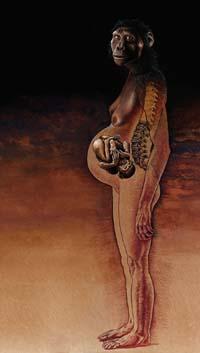Female vertebral column adapted to pregnancies

In addition to hips, the female spine is different from the male one, to respond to the needs of pregnancy and childbirth. According to a study by Harvard University, the female vertebral column has a higher inclination capacity, which makes it easier for pregnant women to remain standing.
As the pregnancy progresses, the female center of gravity advances. To avoid falling forward, pregnant women bend their backs backwards (up to 28 degrees according to this study).
The increase of the inclination of the back is possible because in the lower part of the column the body of the woman presents a series of differentiated characteristics: on the one hand, the vertebrae that cause the inclination of the back for the lumbar area are three in the women and only two in the men, which allows the tension of the inclination to be distributed in greater surface and, on the other hand, the joints between these vertebrae are a better 14% to support the force in the men.
Research has revealed that these adaptations are very old. The species of the genus Australopithecus that lived two million years ago already existed. They say they had to appear immediately after starting to walk on two legs, since without that adaptation the back damage would be much greater.





